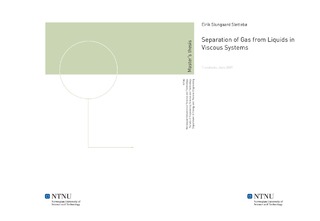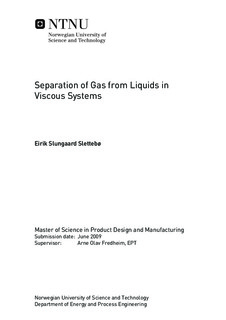| dc.contributor.advisor | Fredheim, Arne Olav | nb_NO |
| dc.contributor.author | Slettebø, Eirik Slungaard | nb_NO |
| dc.date.accessioned | 2014-12-19T11:44:23Z | |
| dc.date.available | 2014-12-19T11:44:23Z | |
| dc.date.created | 2010-09-03 | nb_NO |
| dc.date.issued | 2009 | nb_NO |
| dc.identifier | 347752 | nb_NO |
| dc.identifier | ntnudaim:4803 | nb_NO |
| dc.identifier.uri | http://hdl.handle.net/11250/233602 | |
| dc.description.abstract | Increased knowledge of the degassing process in separation of gas from oil is important in connection with development of subsea separation and boosting units for heavy oil fields. The focus in the thesis is on theory and equipment design for two-phase separation of oil and gas. A review of gravitational separators and compact separation technology with a focus on subsea installations is given first. An extensive literature review related to theory governing the degassing process is further presented. The effectiveness of the degassing process depends on the gas’ ability to migrate out of the oil. Bubble dynamics theory, especially correlations for calculation of a bubbles velocity in a liquid is therefore examined. Bubble size, fluid properties, especially liquid viscosity, and gas volume fraction in the liquid is decisive factors for the bubble velocity. A comparison of several correlations obtained in various literature is made to determine the best available for modeling degassing. Most of the correlations have a limited range of validity in terms of bubble size and Reynolds number. It is verified that they are highly inaccurate outside this range. A correlation developed to be valid for a large range of bubble sizes seems to predict bubble velocities reasonably well. Because of its large range of validity, this is chosen to be used in the development of a separator model. Some experimental work is performed on two liquids with different viscosity. It is verified that separation of gas in viscous liquids requires significantly more retention time for the smallest bubbles reach the liquid surface. Occasional deviations from the examined theory are observed, especially for the more viscous liquid. Based the chosen correlation for bubble velocity a simplified model for horizontal and vertical gravity separators is developed. Separator size, fluid properties, flow rate and distribution of bubbles are input parameters. The model calculates how much of the initial gas volume fraction that remains in the liquid after separation. Consequence of high liquid viscosity and distribution of bubble size and bubble distribution in the liquid are evaluated by use of the model. When the oil becomes very viscous is it important that separator and internals are designed to optimize the conditions for degassing. This implies among others an inlet device which provides an ability to control the bubble distribution and keep the size of bubbles as large as possible. Methods are suggested for increased effectiveness in degassing of heavy oils, by reducing viscosity, increase the coalescence rate and affecting the flow pattern. Separation of other phases and undesirable components is also important and may make it difficult to optimize the design for the degassing process. However, a separator should be efficient in all respects, making knowledge of the degassing process anyhow important. The thesis gives an overview of important parameters in the degassing process. Much work still remains to develop correlations and models which can give a more exact description of real systems. Continuous development in separator components and not at least compact separation technology is important to effectively be able to produce heavy oil, especially in terms of subsea installations. | nb_NO |
| dc.language | eng | nb_NO |
| dc.publisher | Institutt for energi- og prosessteknikk | nb_NO |
| dc.subject | ntnudaim | no_NO |
| dc.subject | MTPROD produktutvikling og produksjon | no_NO |
| dc.subject | Energi- | no_NO |
| dc.subject | prosess- og strømningsteknikk | no_NO |
| dc.title | Separation of Gas from Liquids in Viscous Systems | nb_NO |
| dc.type | Master thesis | nb_NO |
| dc.source.pagenumber | 136 | nb_NO |
| dc.contributor.department | Norges teknisk-naturvitenskapelige universitet, Fakultet for ingeniørvitenskap og teknologi, Institutt for energi- og prosessteknikk | nb_NO |

